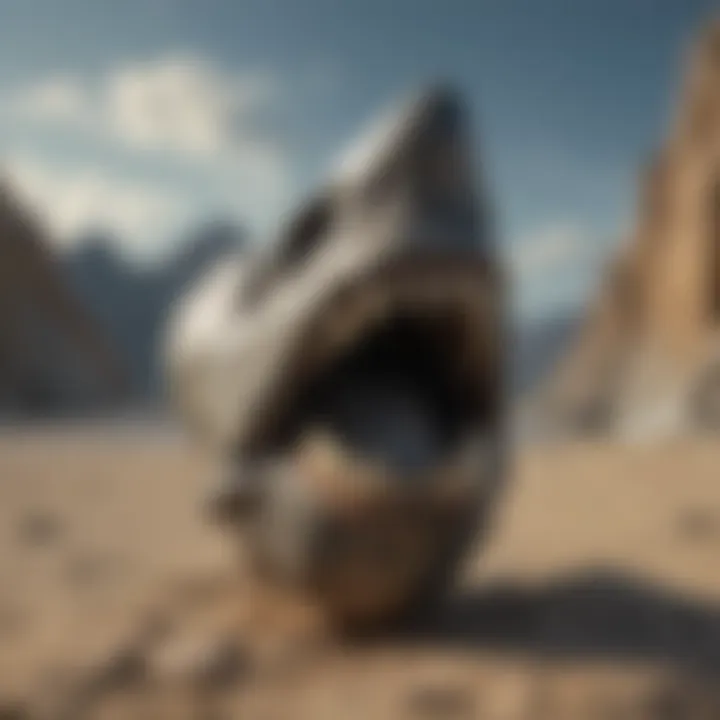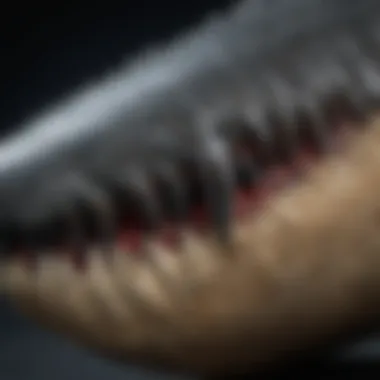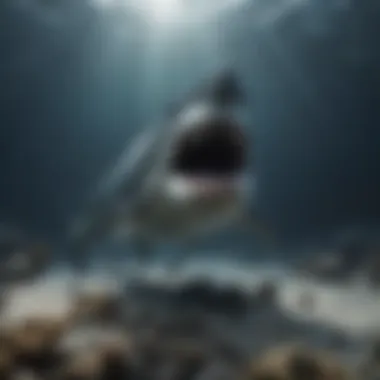Uncovering the Allure of Fossilized Megalodon Teeth


Intro
The allure of fossilized megalodon teeth captivates both enthusiasts and researchers alike. Megalodons, the apex predators of the ancient oceans, thrived during the Cenozoic era. Their massive teeth have become symbols of prehistoric power and mystery. They shed light on marine ecosystems long gone and provide insights into the evolution of sharks. This article examines the significant role these teeth play in paleontology, explores the characteristics that make them unique, and discusses the booming collector's market surrounding them.
As we dive into this subject, we will explore the formation, identification, and preservation methods of megalodon teeth, giving valuable information for both collectors and academics. Moreover, we will highlight how these fossils contribute to our understanding of sea life in eras past.
Featured Collectible of the Month
Overview
Megalodon teeth are among the most sought-after fossils in the world. They are prized not only for their size but also for their history and rarity. Collectors often look for complete specimens, which can measure over seven inches in length. These remarkable teeth can fetch high prices in the collectors’ market, depending on their condition and provenance.
In the past few years, the interest in fossilized megalodon teeth has surged, with more people looking to start their own collections or enrich existing ones. Social media platforms like Facebook and Reddit have become popular places to share finds, buy, and sell these ancient treasures.
Historical Significance
The megalodon existed approximately 23 to 3.6 million years ago. During this time, these massive sharks roamed the oceans. Their teeth, which are capable of inflicting serious damage, provide insights into their feeding habits and biology. Each tooth serves as a record of what these creatures hunted and consumed, revealing the dynamics of ancient marine ecosystems. The discovery of megalodon teeth in various parts of the world indicates their extensive range and dominance in fossil food chains.
Fossilized teeth help researchers understand not only the megalodon but also the environments they inhabited. Analysis of these relics has led to revelations about climate change, species adaptation, and ocean health. As such, megalodon teeth do not just interest collectors; they are vital to the ongoing study of marine life’s evolutionary history.
Identification Techniques
Visual Characteristics
Identifying a genuine megalodon tooth is crucial for any collector. These teeth are characterized by their large, triangular shape, serrated edges, and a broad base. Their color can vary widely, typically ranging from black, brown, grey, to even white. Some teeth may display unique patterns or lines that show their age and origin.
When looking for authenticity, collectors should consider the following factors:
- Size: Genuine megalodon teeth often exceed three inches.
- Serration: Effective for slicing through flesh, the serrations should appear sharp and distinct.
- Patina: An old tooth should have a weathered appearance, often with a smooth surface
- Root Structure: The root of the tooth can help you determine whether it is real or a reproduction.
Resources for Identification
Numerous resources exist for aspiring collectors to enhance their understanding and help them identify megalodon teeth. Some useful resources include:
- Wikipedia: Provides comprehensive information on megalodons and fossil identification. Wikipedia
- Encyclopedia Britannica: Offers articles and insights into marine paleontology. Britannica
- Online Forums: Platforms like Reddit have subreddits dedicated to fossils, providing a space for collectors to share insights and experiences. Reddit
- Collectors’ Groups on Facebook: Various groups discuss identification techniques and trading opportunities. Facebook
Investing time in research can bolster your knowledge and collection quality, ensuring that what you acquire is both authentic and valuable.
"Megalodon teeth are more than just fossils; they are windows into a prehistoric world, reflecting the mysteries of evolution and survival."
Ultimately, the study of megalodon teeth offers profound insights into past oceanic life, while the excitement of collecting them fuels passion and community among enthusiasts.
Preface to Megalodon
The exploration of megalodon teeth is not merely a pass-time for fossil collectors; it represents a gateway into understanding a crucial part of our planet's ancient marine ecosystems. Megalodon, scientifically known as Carcharocles megalodon, stands as one of the largest known predators to have ever existed. Its teeth provide significant insight into its life and the environments it inhabited. In this section, we will delve into the core aspects of the megalodon, enriching our understanding of its relevance to paleontology and the fascination that fossilized teeth ignite in collectors and researchers alike.
Understanding the Megalodon
Megalodon lived during the Cenozoic era, primarily between 23 to 3.6 million years ago. It had the ability to grow over 60 feet in length, a size that commands awe. As apex predators, megalodons occupied a vital role within their ecological niche. Their primary prey likely included whales, dolphins, and large fish. The evolution of megalodon teeth showcases adaptations for the consumption of substantial prey, supporting the predator's hunting efficiency.
Megalodon teeth often reach sizes of over 7 inches, notable for their robust construction. These large teeth indicate a diet that required significant biting power and highlight the massive size of the megalodon itself. Fossilized teeth discovered in various locations worldwide trace the geographic spread of these majestic creatures. The study of these teeth not only reveals details about the megalodon’s feeding habits but also offers clues into the biodiversity of the oceans during its time.
Historical Significance


The fascination with megalodon teeth goes beyond their physical attributes; they hold a captivating place in human history and culture. Fossils have been documented as far back as ancient civilizations, where they were often mistaken for dragon teeth or other mythical creatures. As scientific understanding progressed, these artifacts transitioned into valuable resources for paleontology.
The significance of megalodon teeth extends into various fields such as geology and evolutionary biology. They help researchers understand climate changes over geological time scales. Moreover, the discovery of megalodon teeth helps to construct ancient oceanic food webs, illustrating the relationship between different marine species.
"Megalodon teeth serve as a remarkable window into the past, allowing us to piece together the mysteries of ancient marine ecosystems."
Collectors value megalodon teeth not solely for their aesthetic appeal but for the story they represent—a narrative interwoven with evolution, survival, and extinction. Understanding these aspects deepens the appreciation for fossilized teeth and their implications on our comprehension of the Earth’s biological history.
The Formation of Fossilized Teeth
The essence of understanding the formation of fossilized megalodon teeth lies in comprehending how these ancient relics originate. Fossilization is a rare event that encapsulates biological history. This process not only preserves the teeth but also provides insights about the environments in which megalodons lived. Therefore, recognizing the significance of fossilization can deepen the appreciation for megalodon teeth as both natural artifacts and historical documents.
The Fossilization Process
Fossilization typically involves the slow process of organic material being replaced by minerals. Initially, when megalodon teeth fall to the ocean floor, they are exposed to varying conditions. Over time, sediment accumulates around the teeth. This sedimentation is crucial, as it helps protect the teeth from physical erosion and biological degradation.
Once buried, the conditions become ideal for fossilization. The organic material in the teeth gradually dissolves and is replaced by minerals such as silica or calcium carbonate. This transformation can take thousands to millions of years, depending on the environmental conditions. The final result is a solid tooth that can last for eons.
The process can be influenced by factors like temperature, pressure, and the chemical composition of surrounding sediments. These variables affect the degree of fossilization and the characteristics of the resulting fossil, influencing its appearance, texture, and even size.
Geological Context
The geological context in which megalodon teeth are found is equally vital for understanding their formation. Megalodons existed during the Cenozoic era, mainly from 23 to 2.6 million years ago. The continual changes in marine geology have impacted where and how fossilized teeth are identified. As land masses change, so too do ocean currents and habitats.
Fossilized teeth are often located in locations such as riverbeds and coastal regions, where marine sediments have been uplifted and exposed due to tectonic activities. These contexts not only provide information about the age of the fossils but also about the environment during which the megalodons thrived.
In summary, recognizing the formation process and geological context of megalodon teeth allows collectors and researchers to value these specimens not only as objects of beauty but also as crucial evidence in the larger narrative of earth’s history. Collecting these teeth becomes an endeavor that enriches one’s understanding of past ecosystems and marine life.
Physical Characteristics of Megalodon Teeth
Understanding the physical characteristics of megalodon teeth is crucial for both collectors and researchers alike. These attributes not only help in authenticating these fossils but also offer insights into the evolutionary history of the megalodon and its role in marine ecosystems. The unique features of megalodon teeth can significantly affect their market value and appeal to collectors.
Size and Shape Variations
Megalodon teeth are famous for their impressive size and distinct shapes. On average, a megalodon tooth can reach lengths of 4 to 5 inches, but larger specimens exist, sometimes exceeding 7 inches. The size is not merely a function of the shark's large body; it also reflects its predatory lifestyle, as larger teeth were essential for tearing through the flesh of substantial prey.
The shape of a megalodon tooth varies, with most having a broadly triangular configuration resembling that of modern great white sharks. However, there are variations that indicate the shark's diet and feeding habits. Some teeth are robust and wide, indicating a preference for larger marine animals, while more slender teeth may suggest a diverse diet including smaller fish.
"The size and shape of megalodon teeth provide vital clues into their predatory behavior and ecological niche."
Coloration and Texture
The coloration of megalodon teeth ranges from shades of black and brown to gray and even yellowish hues. These colors arise from various minerals present in the sediment where the teeth fossilized. For collectors, color can significantly influence the perceived value of a tooth. A deep black or dark brown tooth is often more sought after, while lighter colors may be less desirable.
Texture plays a crucial role as well. Megalodon teeth typically exhibit a smooth, glossy surface which was formed during the fossilization process. In some cases, teeth may display fine ridges or striations, offering further detail to their identification. Collectors often appreciate the texture, as it not only enhances the aesthetic appeal but also serves as a point of interest in discussions about paleontology and the history of these magnificent creatures.
Through careful observation of size, shape, coloration, and texture, collectors and researchers can gather significant information about the megalodon and its environment. Understanding these characteristics is essential for anyone engaging with megalodon teeth, whether for academic purposes or personal collections.
Identifying Authentic Megalodon Teeth
Identifying authentic megalodon teeth is crucial for both collectors and researchers. As the demand for these ancient artifacts rises, so does the prevalence of forgeries. Verification is essential to ensure the integrity of a collection and preserve the true historical value of megalodon teeth. Equipped with the knowledge of how to distinguish genuine teeth from replicas, collectors can safeguard their investments and contribute positively to the field of paleontology.
Distinguishing Features
When trying to identify authentic megalodon teeth, several distinguishing features can be examined.


- Size and Shape: Megalodon teeth can be quite large, often reaching lengths of over seven inches. The serrated edges are distinct and arise naturally during their growth. Genuine teeth exhibit a consistent shape that reflects their evolutionary purpose as part of a massive predator.
- Root Features: The root of a megalodon tooth is typically broad and flat. Unlike modern shark teeth, which often have visible grooves or a pronounced ridge, megalodon teeth have a more solidly built base.
- Wear Patterns: Authentic fossils may show signs of age, including wear patterns indicative of long-term use or exposure to elements, such as fossils embedded in sediment. This can be an indicator of their authenticity.
- Color and Texture: Genuine megalodon teeth often exhibit a range of colors due to mineralization over time. The texture can vary from smooth to slightly pitted, representing the natural aging process.
- Preservation State: Real teeth often show signs of wear from natural occurrences. A pristine tooth may raise suspicions about its authenticity, as megalodon teeth are rarely found in perfect condition.
By paying attention to these details, collectors can make informed decisions about their purchases.
Common Forgery Techniques
The market for megalodon teeth has attracted numerous forgeries, which can vary in quality and deception. Familiarity with common forgery techniques is vital for any collector.
- Manufacturer Replicas: Some forgers produce teeth that are almost indistinguishable from authentic ones using molds. These replicas can be made of resin or other synthetic materials, and they may mimic features of real teeth.
- Fossil Treatments: Sometimes, modern teeth are artificially aged through heating or chemical treatments. These processes can create a misleading appearance, often fooling inexperienced collectors.
- Inclusion of Non-Fossilized Material: Some forgers embed modern materials or rework existing fossil pieces to create fake teeth. By adding to or altering identifiable features, they can significantly mislead potential buyers.
- Mislabeling: Forgers often label replica teeth as authentic from certain deposits or locations, where genuine megalodon teeth can be found. This adds a false narrative and potentially increases the tooth's market value.
"Awareness and knowledge are the best tools a collector can have to avoid costly mistakes in the market for megalodon teeth."
By recognizing these forgery techniques, collectors can enhance their ability to identify authentic megalodon teeth and uphold the integrity of their collections.
The Collector's Market for Megalodon Teeth
The market for megalodon teeth is a key aspect of their allure and fascination. Collecting these ancient relics goes beyond mere interest in marine biology; it taps into history, rarity, and the thrill of owning a piece of prehistoric life. The significance of this market is well-founded, intertwining paleontological value with the economic aspects of collecting. Understanding the collector's market provides insights into the historical relevance of megalodon teeth while also highlighting current market dynamics.
Market Trends and Prices
In recent years, the demand for megalodon teeth has surged among collectors, investors, and enthusiasts. This trend is driven by various factors.
- Increase in Public Interest: Documentaries and films featuring megalodons have piqued public interest, leading many to seek their own connection to these fascinating creatures.
- Limited Supply: Fossilized megalodon teeth are rare, particularly large specimens. The scarcity of these items contributes to their high value.
- Diverse Price Range: Prices for megalodon teeth can vary greatly. Smaller teeth might be accessible for a few hundred dollars, while larger, well-preserved specimens often fetch thousands. For instance, a tooth over six inches in length can command prices exceeding ten thousand dollars.
With the rise in popularity, online marketplaces such as eBay and specialized auction sites have become platforms where collectors can buy and sell megalodon teeth. The prices can reflect the market trends, influenced by factors such as tooth size, condition, and provenance. As competition increases, investors must be aware of fluctuations and the potential for price spikes based on public interest or scientific discoveries related to megalodon fossils.
Notable Auction Sales
Several high-profile auction sales of megalodon teeth have made headlines, reinforcing their status as coveted collectibles.
In 2020, a stunning specimen measuring over seven inches sold for an astonishing $25,000. This sale highlighted not only the financial value but also the cultural significance placed on these ancient teeth. Furthermore, the buzz generated from such auctions elevates the profile of megaldon teeth among both collectors and the general public. Some sales lead to heightened interest in the market, prompting collectors who may once have been passive to become active participants.
- Auction Houses: Notable auction houses like Sotheby’s and Christie’s have occasionally featured megalodon teeth, further legitimizing the market.
- Celebrity Involvement: When celebrities publicly showcase their collections or participate in auctions, the media coverage can stimulate interest and demand.
"The allure of owning a piece of history underscores the collector's market for megalodon teeth, intertwining passion with investment."
Overall, the collector's market for megalodon teeth serves as a bridge between conservation, education, and investment. As the fascination continues to grow, so too does the significance of these ancient teeth in both scientific and commercial realms.
Care and Preservation of Fossilized Teeth
Caring for and preserving fossilized megalodon teeth is crucial for several reasons. First, these teeth are not only valuable from a monetary standpoint but also hold significant paleontological insight. They allow researchers and collectors alike to understand better the biology and environment of the megalodon, an apex predator of its time. Proper care ensures that these delicate specimens retain their integrity for generations.
In addition to the intrinsic value of fossilized teeth, their aesthetic appeal can enhance the collection of any enthusiast. Well-preserved teeth can command higher prices in the collector's market. Therefore, knowing how to maintain them can ensure their long-term condition and value.
It is important to consider a few basic elements when it comes to care and preservation. This involves understanding the correct environment, handling techniques, and treatment methods to avoid degradation of these unique artifacts.
Best Practices for Collectors
When it comes to best practices for collectors, there are several guidelines to follow. First, storage plays a vital role. Megalodon teeth should be kept in a stable environment, free from excessive humidity and direct sunlight. Ideally, use an acid-free display case or box to minimize exposure to elements that might contribute to deterioration.
- Use archival-quality materials: Materials that do not emit harmful substances will help prevent chemical reactions that may harm the fossil.
- Avoid cleaning with harsh chemicals: Simple methods, like wiping gently with a dry cloth, are often sufficient.
- Document your collection: Keeping a record of provenance can enhance the value and historical significance of each tooth.
It is also advisable to handle these teeth with care. When displaying them or moving them, always use gloves to prevent oils from your skin from transferring to the specimens.
Display Considerations


When displaying megalodon teeth, several factors merit consideration to enhance both aesthetics and preservation. The display area should be cool and dry, ideally in a controlled environment.
Selecting the right display method is equally important. Some popular methods include:
- Shadow boxes: These provide depth, allowing for a three-dimensional presentation.
- Stands or mounts: Creative display stands can draw attention while protecting the teeth from damage.
- Wall-mounted cases: They save space and allow for a secure view without risk of accidental displacement.
Additionally, consider the arrangement of your collection. Organizing teeth by size, color, or geographical origin can create a more engaging visual narrative. Using lighting strategically can also emphasize the unique textures and patterns of the teeth.
"Proper care and preservation of fossilized teeth not only benefit the current collectors but also future generations who will appreciate these relics of ancient marine life."
In summary, practicing optimal care and preservation of fossilized megalodon teeth enhances their longevity and value. Collectors must involve themselves in understanding the proper techniques and methods to ensure their specimens remain in top condition.
Megalodon in Popular Culture
Megalodon has long captured the imagination of the public, serving as both a fearsome predator and a symbol of prehistoric intrigue. This section explores the various representations of megalodon in literature and film, as well as the myths that have surged around this colossal shark. The influence of megalodon on cultural narratives highlights not only humanity's fascination with extinct species but also the broader implications for how we view nature and its drivers.
Literature and Film
Megalodon often appears as a character in literary works and films, leveraging its massive size and fearsome reputation. Prominent titles include "Meg" by Steve Alten and films like "The Meg," where this ancient creature is portrayed as a surviving relic of a bygone era. Literature often amplifies its physical prowess, narrating stories that blend scientific intrigue with thrilling survival scenarios.
The appeal of these narratives rests heavily on the tension between humans and a powerful predator. Authors and filmmakers tend to illustrate megalodon as a symbol of nature's wrath, reflecting humanity's fear of the unknown depths of the ocean. This idea sustains a dual narrative of fascination and terror, compelling audiences to both fear and admire the magnificence of such an ancient creature.
From graphic novels to blockbuster films, megalodon emerges as more than just a creature; it becomes a complex character that evokes human curiosity about existence and extinction.
Public Fascination and Myths
Megalodon's significance extends beyond mere entertainment. Public fascination is fueled by myths and exaggerated tales, often asserting that this giant shark still lurks in the depths of our oceans. Such claims are not purely fanciful; they tap into deep-seated fears of what remains undiscovered in the vast waters of the planet.
"Megalodon is often depicted as the ultimate apex predator, a title that fuels rumors of its possible existence today."
Several documentaries examine the possibility of megalodon’s survival, utilizing sensational narratives to attract viewers. These programs often function in a grey area between science and speculation, highlighting how myths can shape public interest in paleontology and marine biology. Collectors and enthusiasts sometimes rally around such narratives, prompting discussions regarding the authenticity of fossilized megalodon teeth and their significance in understanding the past.
In summary, megalodon serves as a cultural icon, bridging the gap between ancient mysteries and modern curiosity. Through literature and film, as well as myths that persist in the public domain, megalodon continues to influence how we perceive ancient marine ecosystems. Its place in popular culture reinforces the idea that our fascination with such creatures is a reflection of our broader questions about existence, extinction, and the mysteries that remain beneath the waves.
The Role of Megalodon Teeth in Research
Megalodon teeth serve as crucial artifacts in scientific inquiry. Their unique physical attributes and geological context provide insights into the biology and ecology of one of the most formidable marine predators in history. Understanding the role these teeth play in research can amplify our comprehension of prehistoric marine life and its evolution over millions of years.
Paleontological Insights
The study of megalodon teeth yields valuable paleontological insights. First, their size and shape variations indicate evolutionary adaptations. Paleontologists study these changes to track the environmental pressures faced by megalodons. For example, a larger tooth size could imply competition for prey or changes in available food sources.
Fossilized teeth also inform us of the megalodon’s predatory behavior. The serrated edges on the teeth suggest powerful slicing capabilities, pointing to their diet, which likely included large marine animals like whales. Such insights help reconstruct ancient ecosystems, revealing a dynamic web of interactions among species.
Moreover, collecting data on megalodon teeth assists in understanding extinction events. Researchers can correlate teeth findings with climatic and environmental shifts, leading to broader discussions about the resilience or vulnerability of ancient species.
Finale
The conclusion serves as a crucial element in this article, encapsulating the multifaceted allure of fossilized megalodon teeth. This section reiterates the significance of these artifacts in both paleontological research and the collector's market. The findings highlight the intersection of scientific inquiry and personal passion that drives interest in megalodon teeth.
The Enduring Appeal of Megalodon Teeth
Fossilized megalodon teeth are not just objects of curiosity; they represent a connection to a prehistoric world that once thrived in our oceans. The sheer size and unique characteristics of these teeth captivate both collectors and researchers alike. Many enthusiasts view their collection as a journey through time, where each tooth tells a story of the earth's past.
Collectors often prize these teeth for their rarity and historical significance. Size variations can offer insights into megalodon behavior and diet, making each piece a valuable addition to any display. Furthermore, the aesthetic appeal, with intricate patterns and coloration, adds to their desirability as collectible items.
Future Perspectives in Collecting and Research
Looking ahead, the interest in fossilized megalodon teeth is poised to grow. Advances in technology may allow for deeper research into their ecological roles and provide better means of verification for authenticity. This could reshape the collector's market, making it even more vibrant.
In addition, educational initiatives promoting awareness about marine ecosystems and paleontology are emerging. These programs may inspire new generations of collectors and researchers, ensuring that the fascination with megalodon remains alive. As more discoveries are made, the narrative surrounding these ancient relics will continue to evolve, bringing with it fresh insights and compelling challenges for enthusiasts and scientists alike.



